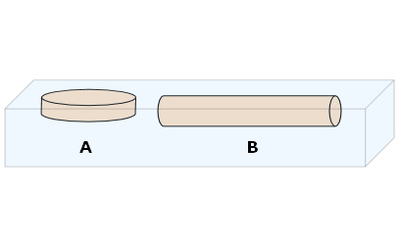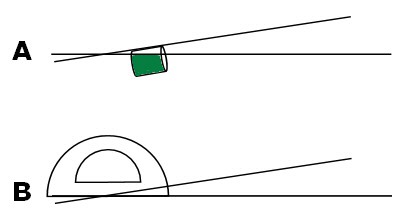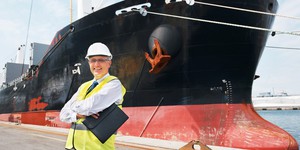Abstract
This science project presents an interesting puzzle. A disk of wood will float face-up; that is, with its circular cross-section parallel to the surface of the water. A long log of wood, however, floats on its side with the circular cross-section perpendicular to the surface of the water. If you think about it, disks and logs are both cylinders. Is there some intermediate length of cylinder that floats with the circular cross-section at a tilted angle? Try this experiment to find out!Summary
Justin Spahn, Science Buddies
Edited by Sandra Slutz, PhD, Science Buddies
Sources
This science project was suggested to Science Buddies by Stewart Levin, PhD, who got the idea from the following article:- Gilbert, E.N. (1991). "How Things Float," The American Mathematical Monthly, 98 (3, March): 201–216.

Objective
The goal of this science project is to measure how the tilt angle of cylinders floating in water depends on the aspect ratio (length/diameter) of the cylinder.Introduction
If you place a wooden disk in water, it floats 'face up,' i.e., with the circular cross-section parallel to the surface of the water. However, if you place a long wooden cylinder in water, it floats on its side with the circular cross-section perpendicular to the surface of the water (see Figure 1).

Figure 1. Illustration of a floating disk (A) and a floating cylinder (B).
If you think about it, a disk is a cylinder, too. A disk is just a very short cylinder, and disk is just a special name for this type of cylinder. How short does a cylinder need to be before you can call it a disk, or is there something more to it? A coaster for a hot cup of coffee certainly fits our concept of a disk. A ceramic coaster might be almost 1 centimeter (cm) tall and 10 cm in diameter. However, you wouldn't call a 1-cm length of pencil lead a disk, you'd call it a cylinder. That's because the diameter of the pencil lead is only 0.05 cm (0.5 mm). So apparently, you should consider both the length and the diameter of a cylinder when deciding whether or not it's a disk.
A handy way to consider both numbers at once is to use a ratio. For example, if you use the ratio:
The coaster has an aspect ratio of 1/10, and the pencil lead has an aspect ratio of 1/0.05 or 20. So perhaps what disk means is a cylinder with an aspect ratio < 1.
Does the way a cylinder floats also depend on its aspect ratio? Since the disk floats face-up, but a longer cylinder floats on its side with the circular faces perpendicular to the surface, does that mean that there are cylinders with intermediate aspect ratios that would float at intermediate angles? Try this science project to find out!
Terms and Concepts
- Ratio
- Aspect ratio
- Buoyancy
- Volume
- Mass
- Density
- Center of gravity
- Center of buoyancy
- Righting moment
Questions
- What is the difference between the center of gravity of the cylinder and its center of buoyancy?
Bibliography
- Ask A Scientist (n.d.). Why Things Float. Retrieved September 19, 2010.
- Guillemot Kayaks. (n.d.). Kayak Stability. Retrieved September 7, 2010.
- Wikipedia Contributors. (2006, December 29). Buoyancy. Wikipedia: The Free Encyclopedia. Retrieved December 29, 2006.
Materials and Equipment
- Wood dowels, 1-inch (in.) and 0.5-in. diameter (2 of each); available in the lumber section of most hardware stores
- Safety goggles; available at your local hardware store
- Small handsaw for cutting dowels to various lengths
- You might even want to visit a hobby store to purchase a small aluminum miter box with a razor saw to go along with it. With a miter box to hold the dowel in place, it is easier to make perpendicular cuts.
- X-ACTO and Zona are two quality brand names to look for. Both companies offer miter boxes and saws.
- Dish pan, approximately 8 inches by 13 inches, or similar sized plastic container
- Water
- Measuring cup
- Colored gelatin mix (6 6-oz packages, or enough to make 6 quarts (qt.) worth of gelatin)
- Pan
- Stove
- Metric ruler
- Protractor
- Pencil
- Blank paper
- Graph paper
- Calculator
- Lab notebook
Experimental Procedure
- With an adult's help, use a hand saw to cut cylinders of various lengths from a long piece of dowel. You'll need to experiment and figure out what range of lengths you need in order to see different tilt angles in water.
- Measuring the aspect ratio of your cylinders is easy. Just measure the length (in cm) and the diameter (in cm), then divide the length by the diameter.
- Prepare the gelatin-and-cylinder setup, as follows:
- Using the package instructions, pot, measuring cup, and stove, make 2 qt. of colored gelatin.
- You'll need two 6-ounce (oz.) packages to make 2 qt. of gelatin. This works best if you use a strong color like blue, red, or purple, If you have clear gelatin, you can add your own food coloring.
- Use caution around the hot liquid gelatin.
- With an adult's help, pour the liquid gelatin into the dish pan.
- Carefully place the dish pan filled with gelatin in the refrigerator to set. Then gently place the dowels in the liquid, as far away from the edges as possible, making sure that they don't roll too much. Note: Rolling a little isn't a problem as long as the dowels finally come to a rest so that they are not touching either the sides of the container or another dowel.
- You might need to occasionally nudge the cylinders away from the edge of the dish.
- Once the gelatin has set, approximately 4 hours later, remove the cylinders from the gelatin.
- The food coloring in the gelatin will stain the submerged portion of each cylinder. There will be a distinct line of dye making the water line on each cylinder.
- Using the package instructions, pot, measuring cup, and stove, make 2 qt. of colored gelatin.
- Use the following steps to measure the tilt angle of each cylinder:
- Using a pencil and a ruler, draw a straight line on a piece of paper.
- Place the dyed cylinder over the straight line, and tilt it until the dye line on the cylinder is parallel with the line on the paper (Figure 2A).
- Holding the cylinder in place, place a ruler against the cylinder at the same angle. (Figure 2A).
- Move the cylinder out of the way and use the ruler to draw a straight line that intersects with the original line on the paper.
- Use your protractor to measure the angle between the two lines (Figure 2B).
- To keep track of your measurements, we suggest that you use a separate sheet of paper for each cylinder. Label each angle drawing with the length, diameter, and aspect ratio of the cylinder.

Figure 2. Measuring the tilt angle of the dyed dowel.
- Make a data table of your results in your lab notebook:
Length
(cm)Diameter
(cm)Aspect Ratio
(length/diameter)Tilt Angle
(°) - Make a graph of your results by plotting tilt angle (y-axis) vs. aspect ratio (x-axis). Over what range of aspect ratios does the tilt angle change?
- Repeat steps 3–6 of the procedure twice more using the same cylinders. Repeating the procedure allows you to determine if your observations are reliable.
- Do the graphs look similar for each repeat of the experiment?
- Over what range of aspect ratios does the tilt angle change?
Ask an Expert
Global Connections
The United Nations Sustainable Development Goals (UNSDGs) are a blueprint to achieve a better and more sustainable future for all.
Variations
- Try dowels of different diameters, but with the same density. For each diameter, cut dowels of various lengths and measure their flotation angles. Make a graph of flotation angle (y-axis) vs. length of the cylinder (x-axis). Use a distinct symbol for each diameter. How do the graphs compare for each cylinder diameter? Now make a graph of flotation angle (y-axis) vs. aspect ratio of the cylinder (length/diameter) (x-axis). Use the same symbols as before. How do these graphs compare?
- Try cylinders with different densities. Is the relationship between flotation angle and aspect ratio the same or different? Can you find cylinders made of different materials but with the same density? Do they have the same relationship between flotation angle and aspect ratio?
- For more advanced students: Can you come up with an explanation of the physics behind the tilt angle vs. aspect ratio relationship? Can you figure out an equation that describes the relationship between tilt angle and aspect ratio? The following article will be a useful reference: Gilbert, E.N. (1991). "How Things Float." The American Mathematical Monthly, 98 (3, March): 201–216.
Careers
If you like this project, you might enjoy exploring these related careers:
Related Links
- Science Fair Project Guide
- Other Ideas Like This
- Aerodynamics & Hydrodynamics Project Ideas
- My Favorites












